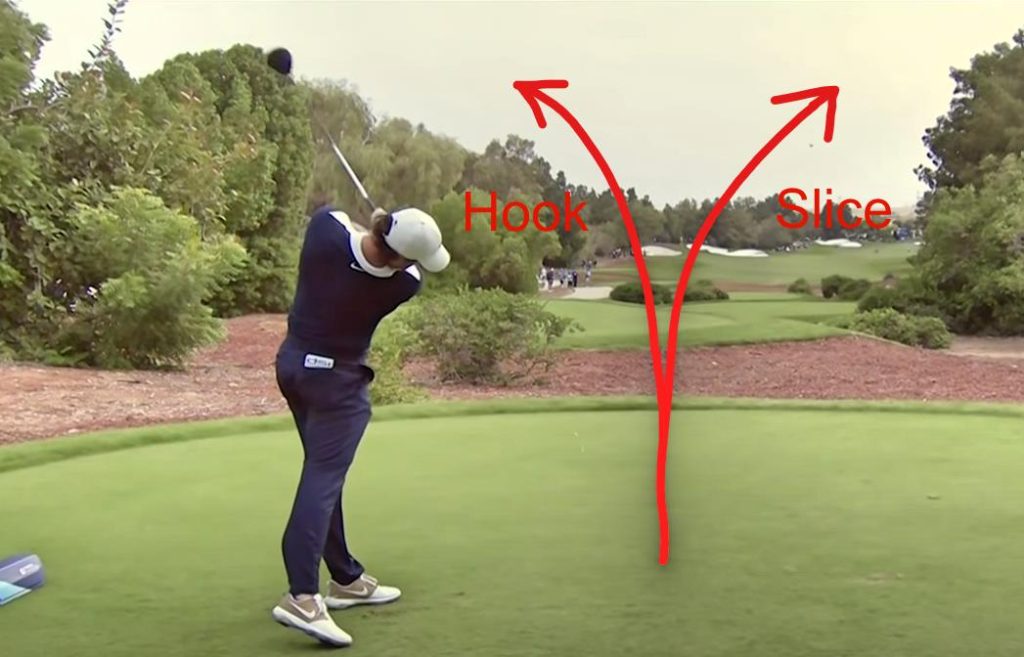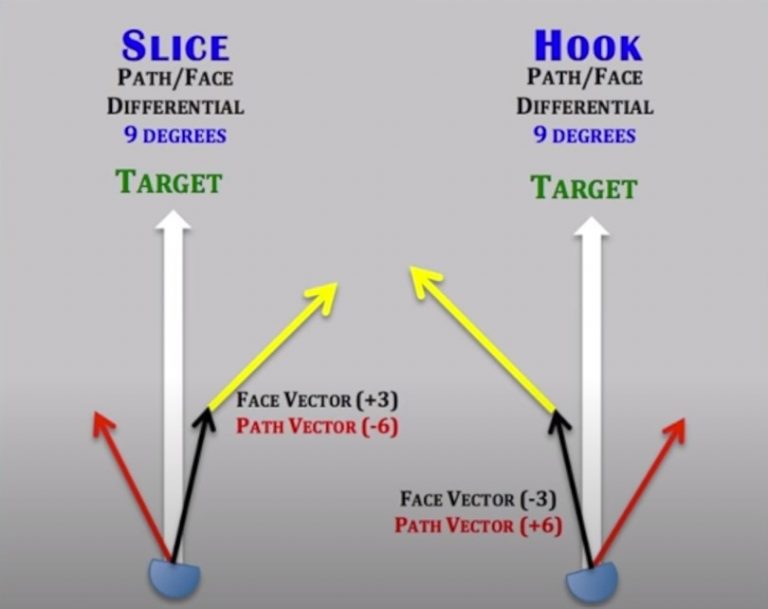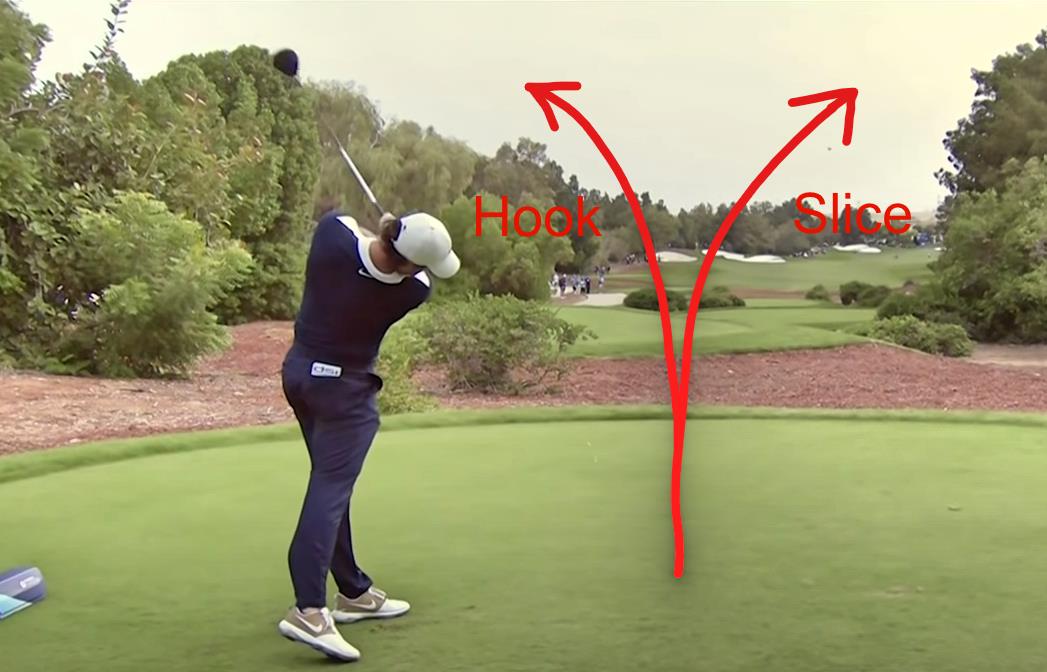Golfers rarely hit shots that are perfectly straight. The only explanation for this is that they require perfectly balanced swings for such shots. Curved shots occur when the ball changes direction relative to the swing in its flight before landing. Comparatively speaking, these shots are significantly simpler to repeat than perfectly straight shoots.

There are two different types of curved shots; the first turns to the left and is known as a hook, while the second turns to the right and is known as a slice. These instructions are for right-handed golfers, so they must be inverted for left-handed golfers.
The Meaning of Slice and Hook Shots

On a golf course, you’ll frequently hear a player lament that they hooked or sliced their ball into the rough or out of bounds. These are the unwanted hooks and slices that happen when a player swings awkwardly or mishits the ball while trying to hit it as straight as they can. Undoubtedly, every golfer who has ever picked up a club has made their fair share of hooks or slices that have hurt their score.
On the other hand, golfers can use hooks and slices in a variety of ways and they can be very desirable shots. Some players’ natural instinct is to slice or hook the ball because they know that it will travel in a direction that will bring it close to where they want to hit it.
Golf commentators and pundits occasionally use terms like “fade” to describe a slice and “draw” to describe a hook. Fade and draw are more frequently used when there is only a slight curve to the right or left in the ball’s flight, depending on how much the ball has been hooked or sliced.
Why are Slice and Hook Shots Used?
Golf slices and hooks are more frequent than straight shots but are not always bad. Due to their repeatability and versatility on the golf course, they are useful skills to learn even though they may take some time to master. You might assume that if the ball curves as it travels toward the target, it will be more challenging to hit it towards the target than if it travels straight, but for many golfers, including professionals, this is not the case.
You will learn that you can control how much the ball moves during its trajectory as you practise slices and hooks. You achieve this by striking the ball at slightly different positions and at slightly different angles. Controlling these with your club swing, hooks, and slices can quickly become a method of playing consistently in a game. They are useful for navigating obstacles on golf courses as well.
Golfers frequently refer to a slice as an error, but when it is intentional, the turn is typically less abrupt and is referred to as a “fade.” Similar to how it would turn more gently when a golfer intended a hook, a “draw” is what it is called. Depending on the shape of the intended shot, a player would “draw” or “fade” the ball.

When are These Shots Generally Used?
Slices (also known as fades) and hooks (also known as draws) may become a crucial component of any golf game you play once you get the hang of them. When driving a long distance when the goal is not directly in front of you, you can employ both slices and hooks. These shots are particularly helpful on golf courses with a lot of bends in the fairways, such as “dog-leg” holes where the green can be at a right angle of 90 degrees to the tee.
When playing your ball around natural obstructions like trees and dense bushes, or when there is no direct shot to your target from where your ball is lying, a hook or slice can also be helpful.
Hitting a Hook vs Slice in Golf
Three factors control the trajectory of the ball while hitting a hook or slice in golf. These are angle of attack, club path, and clubface position. The angle of attack is the angle between the club and the ground at the point where it strikes the ball. If this angle is low, the ball is likely to shoot at a low height and hook. If this angle is high, the swing is like a chopping motion and the ball will jump higher and slice.
The club path is another factor which is often a determinant of how the ball moves in the air. When the club travels away from your body on its way down, it hits the ball on the outer side. This makes the ball hook due to the inward force experienced by it. When the club travels towards your body before impact, it hits the ball on its inner side and makes it slice due to the outward force of this motion.
The position of the clubface is also important in whether you plan to hit a slice or a hook. When the clubface points straight towards the target, it is called a square clubface. When the clubface points inwards towards yourself, it is called a closed clubface and the ball tends to hook in this instance. On the other hand, when the clubface points away from you, it is called an open clubface and is used for slicing.
When to Use Slices
Some situations occur often in golf when a slice could be a beneficial choice of shot. For a right-handed player, a slice can be used when playing a hole with a drastic dogleg towards the right. For a left-handed player, this would be the case with a left dogleg. A small or big slice can also be used when the ball is stuck behind an obstacle in the woods and you need to get around it. In both these cases, the club should move in an outside-to-in path with an open clubface.
When to Use Hooks
In similar circumstances where the required direction is the opposite, hooks are employed. A hook is the best shot option for a right-handed player on a left dogleg in the course. Left-handed players who use the hook shot are said to be playing right doglegs. Similar to slices, hooks are another technique used to curve the ball around forest obstacles.
The best place for your ball to land depends on the final direction you want the ball to go and which shot you want to take. The best way to hit hooks is with a closed clubface and an inside-to-out path.

